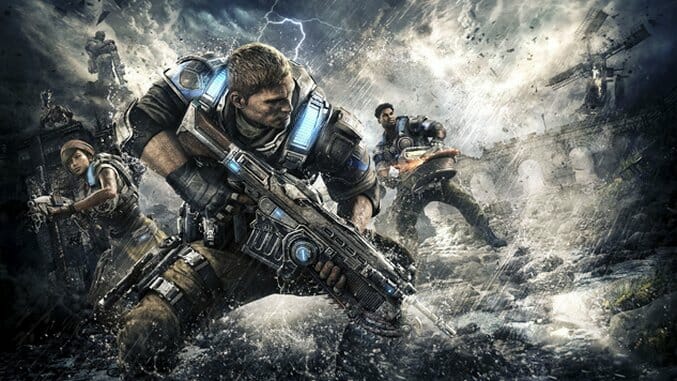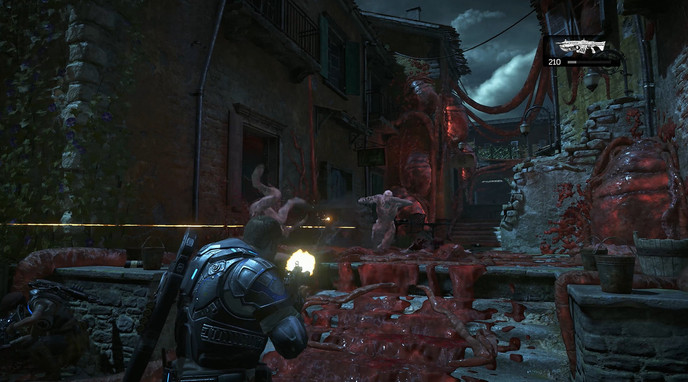
The first Gears of War trilogy was a pillar of any LAN party in the Xbox 360 era. Despite existing in a market oversaturated with multiplayer shooters, even directly competing with another Microsoft exclusive, it found a niche and played into it. The “bro-tastic” perception of Gears is not undeserved, though it paints the series in a less negative light than it sounds. Gears offered cooperative play in the best ways, through campaign and horde, and its hulking band of buddies that would make a Predator casting call blush grew into memorable faces.
Gears of War 4 brings the series into a new generation with the same determined focus of its predecessors. There’s no denying Gears of War 4 is a house built with blueprints; you will roadie run into cover, pop up and down like prairie dogs and chainsaw enemies in half with the infamous Lancer.
What makes Gears of War 4 work is the way it satisfies those creature comforts, a need for exactly this kind of experience, polished and shiny on a new system. The Coalition had a lot to tackle when it inherited the series from Epic Games, but smart choices on when and where to innovate, and when to not fix what isn’t broken, make Gears 4 a welcome surprise.
Set a full generation after the end of 3, the player is dragged through a short prologue that summarizes the conflict of the first trilogy before being introduced to the new generation of Gears. JD Fenix takes the lead role, alongside frat COG buddy Del and outsider Kait. The parallels to the original Gears of War are clear at first, but the cast quickly establishes itself as a unique unit. JD is headstrong but brash, Del’s comic relief runs parallel to his loyalty to the crew, and Kait is aggressive and endearing, a welcome change from the series’ previous female leads. Over time, you get to delve into the nuances, and through clever pacing and a surprising amount of quiet moments between firefights, you get glimpses of actual character development. I enjoyed the original Gears cast for their charisma, the bombastic “woo’s” of Cole and their banter during combat. JD, Del and Kait still have good banter, but they take the time to chat and actually care about each other during their journey.
Gears of War 4’s campaign is definitely a road trip, starting with a raid-gone-wrong and pinwheeling into a global crisis. It’s over-the-top, but comes with a self-awareness that keeps the grandeur in check. This is best characterized in the return of Marcus Fenix, a section that is almost sublimely tongue-in-cheek; “old man” Marcus is settled-down, no-nonsense, but has empathy for the new generation and fills a father-role for all of them, not just JD. At the same time, he can drop a one-liner with ease, with enough cheese that you expect him to turn to the camera and wink.
The chemistry of the cast pushes the story forward more than anything else. As a whole, this isn’t quite the best in Gears campaigns. It starts strong, with a new cast, a bright world free of Locust, and a new enemy in the COG’s automated robot enforcers. Pitting the newcomers against the classic good guys isn’t just an interesting twist, it provides combat situation that feel unique compared to the common conceit of Gears.
Flying Guardians and rolling, self-destructing Trackers force you out of your comfort zone, away from that one perfect piece of cover you’ve been ducking behind and around the arena. New mobility options, like yanking enemies out of cover for executions, and weapons like the Dropshot, which flies overhead and then drops an explosive on foes, give both you and your enemies more options for coping with cover, a welcome change of pace that keeps the action from becoming stagnant.
The world of the first two acts of Gears of War 4 is vibrant, violent and invigorating. When it comes to the latter half of the campaign however, the pacing slows to a grinding halt. Old enemies get rehashed, and the game starts to feel too familiar. Combine this with the maddening, increasing pace of conflicts that are little more than ever-expanding meat lockers of enemies to mow down, and Gears 4 ends up struggling until its final act, where it does away with pretense and brings out the biggest set pieces and guns.
The clever bits of the campaign are where the designers introduce diluted elements of Horde, the mode that for many (myself included) will be the determining factor of whether to boot up Gears again after the credits roll. I’m not as competitive in Gears as other shooters; I find myself constantly drifting to the never-ending onslaught of Horde over the multiplayer modes, and with Gears of War 4, Horde is once again the main attraction post-campaign.
Horde 3.0, as The Coalition calls it, is fleshed out to an irrational amount. The Fabricator, a mobile base that players can move around the map, allows you to craft a bevy of static defenses in exchange for power, a currency earned for killing enemies and clearing waves. Before the match begins, each of the five players in a Horde match selects a class and equips bonuses to accentuate their class’ strengths. Scouts get extra power when they pick it up during a firefight, engineers get better build options and discounts, and the rest of the classes (Soldier, Heavy and Sniper) focus on downing enemies.
These changes make Horde 3.0 a more fluid, unique experience. It’s not so much a simple holdout, but a calculated, cooperative defense. In my first match, we were already growing accustomed to the intricacies and interplay of our classes. Snipers would mark out enemies, while my Heavy bonus gave me bonus damage on anyone marked. Scouts would dart between cover to nab the power enemies dropped, then run it back to the Fabricator, where our engineer was laying out a massive turret line for the upcoming boss wave. Levelling up the selected class to earn more card slots seems daunting at first, as a single run through 50 waves on Normal only netted me two-and-a-half levels, but I appreciate the sense of progression it offers. Horde feels like something I can come back to repeatedly, and with some more carrots than usual dangling at the end of the stick, I could see myself investing more than I usually do.
The competitive multiplayer has also received a number of new features, though these fall more into the “more of the same” category. There’s no drastic overhaul like what the Fabricator or classes brings to Horde, but Gears’ multiplayer never needed that in the first place. The focus in this third section of the game is on competition: running 60 frames per second compared to the other modes’ 30, and a greater focus on placement matches, competitive ranking and numbers. I loathe invoking this, but Gears of War 4’s competitive multiplayer leans heavily into the e-sports crowd, or those aspirational to e-sports at least.
Though it’s not what I come to Gears for, I appreciate the other features added to this iteration’s multiplayer. There’s several new modes that are engaging, like Guardian and Arms Race, the latter of which is The Coalition’s take on the classic “gun game” archetype of getting a kill with every weapon in the game’s locker. Dodgeball is by far my favorite gametype, and the one I’m most eager to play among the modes. A twist on classic deathmatch, everyone has a single life, but getting a kill earns their team a respawn. Like catching the dodgeball in gym, you both take out the other team’s player and bring one of yours back in. Also like gym dodgeball, it can lead to insane 5v1 comeback stories and intense situations.
Where Gears 4 begins to lose me is in the clutter surrounding its multiplayer. The aforementioned “cards,” which can be anything from Horde mode bonuses or bounties that speed up your progression to weapon skins and cosmetics, are all acquired through crates. Microtransactions litter every corner of Gears of War 4’s progression, and though it isn’t quite pay-to-win, it is certainly pay-to-progress when trying to tackle higher difficulties of Horde.
Cards are randomly drawn from crates that you can purchase with either earned in-game currency or real-world cash, and they end up muddying what is supposed to be the game’s lifeblood. Even the implementation of these cards is messy, with a trove of menus that seem unintuitive or unresponsive. Several times I entered a match with a different bounty than I had set, or had to go through four different menus and several sub-menus just to apply the skin I had unlocked for my Lancer.
Still, out-of-game annoyances aside, my greatest grievance with Gears of War 4 is how little it tries to move the bar. I loved the new generation and the pacing of the first two missions. It showed an effort to innovate that had waned near the end of the original trilogy, and there’s 100 percent less use of “Mad World” for faux emotional impact, which is a major plus. But for every surprise or redesign, I saw places where the formula was left too intact, too routine, and those moments keep Gears of War 4 from feeling like a full step forward into a new trilogy.
So as Gears of War moves into its new era (and the game’s ending leaves little doubt regarding that much), I feel cautiously optimistic. I’ve truly enjoyed my time with Gears of War 4, and there’s something to be said for finding creature comforts in the same experience that grabbed me at LAN parties years ago. But comfort breeds complacency, and I hope that as The Coalition gains confidence in their take on the franchise, they continue to push. Gears of War 4 reinvents my favorite game type, plays cheeky at the best times and gives me a cast I can get behind immediately, rather than gradually. This isn’t a grand departure, but it’s a start; for now, that’s enough to keep me coming back game after game, wave after wave for more of what only Gears can do.
Gears of War 4 was developed by The Coalition and published by Microsoft Studios. Our review is based on the Xbox One version. It is also available for PC.
Eric Van Allen is a Texas-based writer. You can follow his e-sports and games rumblings @seamoosi on Twitter.
